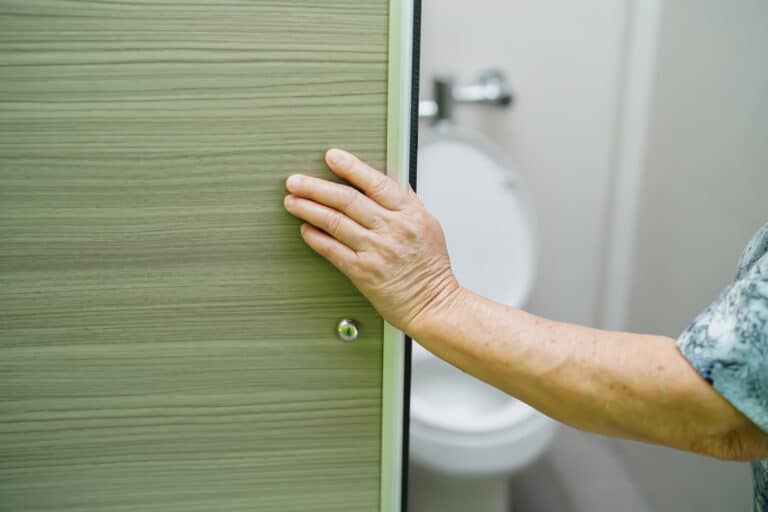Bladder spasms are a common condition that can significantly impact daily life. Spasms are increasingly recognized as a concern in pelvic floor health, especially among older adults who want to maintain mobility and well-being. These involuntary contractions of the bladder, often accompanied by a sudden and intense urge to urinate, can pose challenges that affect one’s overall quality of life.
In this article, we will dig into the intricacies of bladder spasms, exploring their underlying physiological mechanisms and complex relationship with pelvic floor health. Additionally, we will provide practical insights into diagnosing, managing, and preventing bladder spasms.
What Are Bladder Spasms?
Bladder spasms occur when the muscles in the bladder contract involuntarily, causing a sudden and urgent need to urinate. Various factors, including urinary tract infections, bladder irritants such as caffeine or alcohol, certain medications, and neurological conditions, can trigger these spasms. Understanding the underlying causes of bladder spasms is essential in developing effective treatment plans.
To better understand bladder spasms, let’s use an analogy: Imagine your bladder as a balloon and the muscles surrounding it as a rubber band. Typically, the rubber band remains relaxed, allowing the balloon to expand as urine fills the bladder. However, in the case of bladder spasms, the rubber band suddenly tightens, squeezing the balloon and creating a strong urge to urinate.
We’ll cover this in more detail soon, but first lets take a look at some common symptoms to looks for.
Common Symptoms of Bladder Spasms
Frequent Urges: One of the main symptoms is the regular, strong urge to urinate, even if your bladder contains only a small amount of urine.
Sudden Onset: These urges come on suddenly and can be difficult to ignore, often leading to hurried trips to the restroom. Many people describe this as needing to be on constant alert for a nearby bathroom whenever they are outside their homes.
Minimal Warning: Unlike the gradual buildup of pressure you’d feel with a full bladder, bladder spasms can strike with minimal warning, catching you off guard.
The Physiology of Bladder Spasms
Bladder spasms occur due to irregular or premature muscle contractions in the bladder. Put simply, your bladder is a muscular bag designed to store urine until it’s time to go. It’s like having a reservoir in your lower belly.
Typically, the muscles in your bladder remain calm until you consciously decide it’s time to urinate. But when bladder spasms happen, these muscles jump the gun, contracting at inconvenient moments. When these contractions occur at the wrong time, it can lead to that undeniable urge to go, even if you just went.
But why do these bladder spasms even happen? Imagine it as a miscommunication between your brain and your bladder muscles, creating that strong and sudden urge you experience.
In some cases, bladder spasms could be due to irritation or inflammation of the bladder lining. They may also stem from neurological factors, such as nerve damage or conditions like multiple sclerosis, which can disrupt the bladder’s communication with the brain, leading to spasms. But sometimes, there’s no apparent cause or rhythm to spasms.1
The Importance of a Healthy Pelvic Floor
Your pelvic floor is a crucial lower body function that often goes unnoticed. It consists of muscles and connective tissue supporting your organs, such as the bladder, rectum, and uterus. Without a strong and healthy pelvic floor, these organs can sag or prolapse, leading to discomfort and potential medical issues.
In addition to supporting your organs, the pelvic floor plays a vital role in maintaining control over bladder and bowel function. It acts as a guardian, allowing you to decide when and where to empty your bladder or bowels. However, various factors can impact the health and strength of your pelvic floor, including hormonal changes, pregnancy, childbirth, and the natural aging process.
Pelvic Floor Dysfunction
Bladder spasms can disrupt the normal functioning of the pelvic floor. These spasms introduce unexpected pressure and contractions to the pelvic floor, disturbing its normal function. While the pelvic floor is designed to be flexible and resilient, repeated bladder spasms can put excessive stress on the muscles. Over time, this added strain can weaken the pelvic floor and potentially lead to issues like urinary incontinence.
As we age, maintaining a healthy pelvic floor becomes even more crucial. Taking care of this unsung hero of our lower body is essential to prevent discomfort, organ prolapse, and bladder and bowel control issues. By understanding the role of the pelvic floor and taking steps to strengthen and support it, we can promote better overall pelvic floor health.
Causes and Triggers of Bladder Spasms

Bladder spasms can be frustrating and disruptive, but understanding their causes and triggers can help you manage them effectively. In this section, we’ll explore common causes, as well as some strategies to keep bladder spasms under control.
Common Causes of Bladder Spasms
Urinary Tract Infections (UTIs): A urinary tract infection is one of the leading culprits behind bladder spasms. UTIs can irritate and inflame the bladder lining, leading to muscle contractions and intense urination urges. Timely treatment of UTIs can often alleviate these symptoms.1
Neurological Conditions: Some neurological conditions can disrupt the normal signaling between the brain and the bladder, leading to spasms. Conditions like multiple sclerosis or spinal cord injuries may affect the nerves controlling bladder function. Addressing the underlying neurological issues is crucial in managing bladder spasms.1
Certain Medications: Surprisingly, some medications, particularly those that affect the bladder’s muscles or nerves, can trigger spasms. Prescription drugs such as antidepressants or opioids may be associated with bladder spasms. Discussing this with your healthcare provider is essential to explore alternative options or adjustments to your treatment plan.1
Post-operative: Bladder spasms can occur after certain abdominal or pelvic surgeries, including urological, gynecological, colorectal, or orthopedic surgeries. These involuntary bladder contractions can complicate the recovery process.3
Identifying Triggers
In addition to the common causes, recognizing your individual triggers for bladder spasms can be a game-changer in managing and preventing them.
Dietary Triggers
Some foods and beverages can trigger bladder spasms. Common culprits include caffeine, alcohol, spicy foods, and artificial sweeteners. Keeping a food diary can help you identify patterns and make informed choices to minimize these triggers.
Stress and Emotional Factors
Stress is notorious for affecting bladder health. High stress levels can exacerbate spasms. Identifying stressors in your life and incorporating relaxation techniques can significantly reduce the frequency and severity of spasms.4
Fluid Intake
While staying hydrated is essential, excessive fluid intake, especially close to bedtime, can increase the likelihood of nighttime spasms. Balancing your fluid intake throughout the day can help you manage this trigger effectively.
Environmental Factors
Specific situations or environments may trigger spasms for some individuals. Cold weather, changes in altitude, or exposure to irritants can all contribute to bladder spasms. Recognizing these factors can help you make proactive adjustments.
You can better navigate this challenging condition by understanding the common causes and your personal triggers for bladder spasms. Working with your healthcare provider to diagnose and treat bladder spasms effectively is essential.
Diagnosis and Treatment Options

Managing bladder spasms involves a multidimensional approach. Firstly, consulting with a healthcare professional specializing in pelvic floor health is essential. They can conduct a thorough evaluation to determine the underlying cause of the spasms and develop an individualized treatment plan. Treatment options may include medications to relax the bladder muscles, lifestyle modifications such as avoiding bladder irritants, and pelvic floor exercises to strengthen the muscles that support the bladder.
Getting a Diagnosis
If you suspect you’re grappling with the discomfort of bladder spasms, seeking a professional diagnosis is the pivotal first step on your path to relief. Your healthcare provider plays a crucial role in identifying the cause of your symptoms and tailoring a treatment plan to suit your specific needs.
The diagnostic journey often begins with thoroughly discussing your medical history and a detailed conversation about your symptoms. Be prepared to share relevant information, such as your dietary habits, fluid intake, and lifestyle factors contributing to your spasms.
Your healthcare provider may physically examine your abdomen and pelvic area. This examination helps rule out other potential causes and pinpoint the source of your discomfort.
A urine analysis is a standard diagnostic tool in assessing bladder health. It can detect signs of infection, blood in the urine, or other abnormalities that might be linked to your spasms.
Depending on your specific symptoms and medical history, your healthcare provider may recommend additional tests, such as urodynamic studies. These tests assess how well your bladder and urethra are functioning, providing valuable insights into the nature of your spasms.1
Remember, early detection through a thorough diagnosis can pave the way for more effective treatment and a better quality of life.
Treatment Approaches
Now, let’s explore the solutions available to address bladder spasms. The optimal treatment approach can vary depending on the underlying cause and each individual’s unique circumstances. Your healthcare provider will collaborate with you to tailor a plan that best suits your needs.
Medications
Medications can sometimes be a cornerstone of treatment. These medications are designed to relax the bladder muscles, reducing the frequency and intensity of spasms. Working closely with your healthcare provider to find the proper medication and dosage for you is essential.
Physical Therapy
Physical therapy for the pelvic floor is a valuable treatment approach. A trained therapist can guide you through exercises and techniques to strengthen and relax your pelvic floor muscles. These exercises can be instrumental in managing and preventing spasms.
Many people have never heard of pelvic floor physical therapy when they come into my clinic, but realize after a few visits that it can benefit their bladder health.2
Lifestyle Modifications
Often, lifestyle changes can play a significant role in managing bladder spasms. This may include dietary adjustments, such as reducing caffeine and alcohol intake, and stress management techniques like mindfulness and relaxation exercises.
Behavioral Therapy
Behavioral therapies, including bladder training, can help you regain control over your bladder and reduce the frequency of spasms. These approaches involve scheduling bathroom visits and gradually increasing the time between them.
Interventional Procedures
In severe cases or when other treatments are ineffective, your healthcare provider may discuss interventional procedures like Botox injections into the bladder or nerve stimulation techniques. These options are typically considered when conservative approaches haven’t yielded the desired results.
Bladder spasm management is not one-size-fits-all. It’s a tailored approach; you can work closely with your healthcare team to determine the most suitable strategy. Open and honest communication with your healthcare provider is paramount to finding the right path toward relief and improved pelvic floor health.
Lifestyle Changes for Pelvic Floor Health
Maintaining a healthy pelvic floor might seem complex, but incorporating simple lifestyle changes into your daily routine can profoundly impact your pelvic floor health. These changes can help you effectively manage bladder spasms.
Staying adequately hydrated is essential for overall health. However, if you experience bladder spasms, it’s important to be mindful of your triggers. While drinking enough water is vital, identify and limit substances that may irritate your bladder, such as caffeine or acidic beverages. Balancing your fluid intake can help maintain bladder health without overstimulating it.
Pelvic floor exercises, commonly known as Kegel exercises, are powerful in supporting and strengthening these essential muscles. Regularly practicing pelvic floor exercises prescribed by a pelvic floor, PT can improve muscle tone and control, reducing the frequency and severity of spasms.
Self-Care and Coping Strategies
Life can be stressful, and stress can aggravate bladder spasms. Incorporating self-care and coping strategies into your daily routine can make a significant difference in managing your symptoms.
- Deep Breathing: Take a moment each day for breathing exercises. Slow, deep breaths can relax your body and alleviate stress, reducing the likelihood of spasms.
- Mindfulness: Practice mindfulness techniques, such as meditation or simply being present in the moment. Mindfulness can help manage stress and anxiety, promoting a sense of calm that benefits your pelvic floor health.
- Yoga combines physical postures, breathing exercises, and relaxation techniques. Many yoga poses specifically target the pelvic floor muscles, providing physical and mental benefits.
- Regular Exercise: Regular physical activity helps maintain a healthy weight and reduces stress. Choose exercises you enjoy, such as walking, swimming, or dancing, and make them a part of your routine.
By incorporating these lifestyle modifications and self-care practices into your daily life, you can take significant strides toward managing bladder spasms and maintaining a healthy pelvic floor. Consistency is critical, and small changes can substantially improve your overall well-being.
Prevention is also vital in managing bladder spasms. By maintaining a healthy lifestyle, including staying hydrated, practicing good bathroom habits, and managing stress, individuals can reduce the frequency and intensity of bladder spasms. Additionally, incorporating pelvic floor exercises into one’s daily routine can help strengthen the muscles that control bladder function.
Key Takeaways
- Bladder spasms can disrupt your life, especially among older adults, but they’re manageable with the right approach.
- Understanding your triggers and seeking professional help are essential steps for effective management.
- A healthy pelvic floor is vital for overall well-being as you age.
- Common symptoms of bladder spasms include frequent and sudden urination urges, often with minimal warning.
- Bladder spasms can disrupt the delicate balance of the pelvic floor, potentially leading to issues like urinary incontinence.
- Diagnosis involves discussions of medical history, physical examinations, urine analysis, and potentially additional tests like urodynamic studies.
- Treatment options for bladder spasms include medications, physical therapy, lifestyle modifications, behavioral therapy, and, in severe cases, interventional procedures.
- Maintaining a healthy lifestyle and self-care can improve pelvic floor health and symptom management.
References
- Wang, T., Huang, W., & Zhang, Y. (2016). Clinical characteristics and urodynamic analysis of urinary dysfunction in multiple sclerosis. Chinese Medical Journal, 129(06), 645-650.
- Wallace, S. L., Miller, L. D., & Mishra, K. (2019). Pelvic floor physical therapy in the treatment of pelvic floor dysfunction in women. Current Opinion in Obstetrics and Gynecology, 31(6), 485-493.
- Chiang, D., Ben‐Meir, D., Pout, K., & Dewan, P. A. (2005). Management of post‐operative bladder spasm. Journal of pediatrics and child health, 41(1‐2), 56-58.
- Sandvik, H., Kveine, E., & Hunskaar, S. (1993). Female urinary incontinence–psychosocial impact, self-care, and consultations. Scandinavian Journal of Caring Sciences, 7(1), 53-56.
- National Association for Continence. (2021). Pelvic Floor Physical Therapy. Retrieved from https://www.nafc.org/pelvic-floor-physical-therapy






